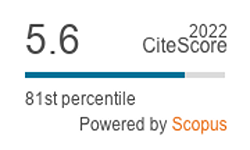Determination of antibiotic resistance patterns of Vibrio parahaemolyticus from shrimp and shellfish in Selangor, Malaysia
DOI:
https://doi.org/10.36877/pmmb.a0000019Abstract
High consumer demand for seafood has led to the need for large-scale, reliable supply through aquaculture farming. However, bacterial infections - which can spread rapidly among the dense farming area pose a major threat to this industry. The farmers therefore often resort to extensive use of antibiotics, both prophylactically and therapeutically, in order to protect their stocks. The extensive use of antibiotics in aquaculture has been postulated to represent a major contributing factor in the rising incidence of antimicrobial resistant pathogenic bacteria in seafood; which may then lead to the spread of antimicrobial resistant bacteria in the environment as well as posing a significant threat to human health. This study aimed to characterize antibiotic resistance of Vibrio parahaemolyticus from shrimp and shellfish in Selangor, Malaysia. The antibiotic susceptibility of 385 V. parahaemolyticus isolates was investigated against 14 antibiotics followed by plasmid profiling and plasmid curing to determine the antibiotic mediation. A large number of isolates showed resistance to ampicillin (85%), amikacin (66.8%), and kanamycin (50.1%). A notable resistance pattern was also observed to the third generation cephalosporins (cefotaxime 55.8% and ceftazidime 34%). Only 338 V. parahaemolyticus isolates had 1-7 different plasmids and could be categorized into 27 patterns based on the number and pattern of plasmid present. Interestingly, there was no correlation between the number of plasmids and antibiotic resistant patterns seen in the isolates. The antibiotic resistance was mediated by both chromosomal and plasmid mediation among the resistant isolates. In summary, our results demonstrate that incidence of pathogenic V. parahaemolyticus in seafood in Selangor remains in relatively assuring levels, however the identification of antibiotic resistance among the isolates does rises a public health concern and warrants for continuous surveillance.
Downloads
Published
Issue
Section
License
Author(s) shall retain the copyright of their work and grant the Journal/Publisher right for the first publication with the work simultaneously licensed under:
Creative Commons Attribution-NonCommercial 4.0 International (CC BY-NC 4.0). This license allows for the copying, distribution and transmission of the work, provided the correct attribution of the original creator is stated. Adaptation and remixing are also permitted.

This broad license intends to facilitate free access to, as well as the unrestricted reuse of, original works of all types for non-commercial purposes.
The author(s) permits HH Publisher to publish this article that has not been submitted elsewhere.



.png)

.jpg)
